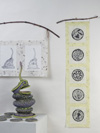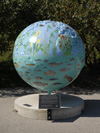Ghost Fish Ghost Forest

In November 2005, Sharon Bladholm was invited to create a site specific piece entitled, "Ghost Fish-Ghost Forest" for the CAPC Musee D Art Contemporain de Bordeaux as part of "Chicago is Now" a component of the Novart Art Festival. Ghost Fish-Ghost forest was created with elements made in her studio, brought to France and combined with materials gathered in Bordeaux. The piece was exhibited at the museum in conjunction with a performance by Kahil El Zabar's and his Ethnic Heritage Ensemble. Kahil was instrumental in organizing this interdicisplinary art event.
Ghost Fish Ghost Forest
"If we do not protect these vibrant long-evolved and delicate webs of life, we will indeed end up with only Ghost Fish, specimens floating in jars, fish contained to aquariums, and even ghosts of fish we never ever had the chance to see. This also relates to whole populations of forest people who's lives are threatened along with the flora and fauna, indeed the whole ecosystem."
The inspiration for this piece came from from her participation on an expedition to the Amazon basin that was co-sponsored by the Field Museum of Natural History and Conservation International. The branch cage of the actual piece housing ghostly white plaster fish speaks not only of containment but also equally of protection and hope as it relates to the round structure of the "Shabonno" that indigenous peoples like the Yanomani inhabit and the type of protection that cultures still intact intrinsically provide.

The wax forms seen at the bottom symbolize water, a natural kind of water full of life, as with an exploding drop of rain water. The surrounding protective circle of white forms represent plant ovaries. The part responsible for reproduction. In only two weeks of collecting specimens on the Pastaza we discovered 22 new species and even a new genus of fish. That is how much is still unknown about these tropical areas. Plants, after all, sustain all life on earth and offer a wealth of benefits in medicines and food supplies. We need to remember to honor and enhance our relationships with the natural botanical world, even as we live our fragmented and industrial information saturation lives.
The indigenous people in the area are natural stewards of the environment as they still live a life that is interdependent upon that larger ecosystem that they inhabit. Every time a forest is cut down, and it's tribal peoples displaced, it's as if a vast and ancient library is destroyed. Thankfully, Western science is starting to recognize the immense knowledge of indigenous people and the true value of positive collaboration with them. This new direction is one of absolute importance to follow for the ultimate survival of this imperiled planet.

Ghost Fish Ghost Forest
"If we do not protect these vibrant long-evolved and delicate webs of life, we will indeed end up with only Ghost Fish, specimens floating in jars, fish contained to aquariums, and even ghosts of fish we never ever had the chance to see. This also relates to whole populations of forest people who's lives are threatened along with the flora and fauna, indeed the whole ecosystem."
The inspiration for this piece came from from her participation on an expedition to the Amazon basin that was co-sponsored by the Field Museum of Natural History and Conservation International. The branch cage of the actual piece housing ghostly white plaster fish speaks not only of containment but also equally of protection and hope as it relates to the round structure of the "Shabonno" that indigenous peoples like the Yanomani inhabit and the type of protection that cultures still intact intrinsically provide.

The wax forms seen at the bottom symbolize water, a natural kind of water full of life, as with an exploding drop of rain water. The surrounding protective circle of white forms represent plant ovaries. The part responsible for reproduction. In only two weeks of collecting specimens on the Pastaza we discovered 22 new species and even a new genus of fish. That is how much is still unknown about these tropical areas. Plants, after all, sustain all life on earth and offer a wealth of benefits in medicines and food supplies. We need to remember to honor and enhance our relationships with the natural botanical world, even as we live our fragmented and industrial information saturation lives.
The indigenous people in the area are natural stewards of the environment as they still live a life that is interdependent upon that larger ecosystem that they inhabit. Every time a forest is cut down, and it's tribal peoples displaced, it's as if a vast and ancient library is destroyed. Thankfully, Western science is starting to recognize the immense knowledge of indigenous people and the true value of positive collaboration with them. This new direction is one of absolute importance to follow for the ultimate survival of this imperiled planet.


















